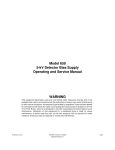Download Model 660 5-kV Detector Bias Supply Operating and Service
Transcript
Model 660
5-kV Detector Bias Supply
Operating and Service Manual
WARNING
This equipment generates, uses and can radiate radio frequency energy, and if not
installed and used in accordance with the instruction manual, may cause interference
to radio communications. As temporarily permitted by regulation it has not been tested
for compliance with limits for Class A computing devices pursuant to Subpart J of Part
15 of FCC Rules, which are designed to provide reasonable protection against such
interference. Operation of this equipment in a residential area is likely to cause
interference, in which case the user, at his own expense, will be required to make
whatever measures may be required to correct the interference.
Printed in U.S.A.
ORTEC® Part No. 753780
Manual Revision H
1202
Advanced Measurement Technology, Inc.
a/k/a/ ORTEC®, a subsidiary of AMETEK®, Inc.
WARRANTY
ORTEC* warrants that the items will be delivered free from defects in material or workmanship. ORTEC makes
no other warranties, express or implied, and specifically NO WARRANTY OF MERCHANTABILITY OR
FITNESS FOR A PARTICULAR PURPOSE.
ORTEC’s exclusive liability is limited to repairing or replacing at ORTEC’s option, items found by ORTEC to
be defective in workmanship or materials within one year from the date of delivery. ORTEC’s liability on any
claim of any kind, including negligence, loss, or damages arising out of, connected with, or from the performance
or breach thereof, or from the manufacture, sale, delivery, resale, repair, or use of any item or services covered
by this agreement or purchase order, shall in no case exceed the price allocable to the item or service furnished
or any part thereof that gives rise to the claim. In the event ORTEC fails to manufacture or deliver items called
for in this agreement or purchase order, ORTEC’s exclusive liability and buyer’s exclusive remedy shall be release
of the buyer from the obligation to pay the purchase price. In no event shall ORTEC be liable for special or
consequential damages.
Quality Control
Before being approved for shipment, each ORTEC instrument must pass a stringent set of quality control tests
designed to expose any flaws in materials or workmanship. Permanent records of these tests are maintained for
use in warranty repair and as a source of statistical information for design improvements.
Repair Service
If it becomes necessary to return this instrument for repair, it is essential that Customer Services be contacted in
advance of its return so that a Return Authorization Number can be assigned to the unit. Also, ORTEC must be
informed, either in writing, by telephone [(865) 482-4411] or by facsimile transmission [(865) 483-2133], of the
nature of the fault of the instrument being returned and of the model, serial, and revision ("Rev" on rear panel)
numbers. Failure to do so may cause unnecessary delays in getting the unit repaired. The ORTEC standard
procedure requires that instruments returned for repair pass the same quality control tests that are used for
new-production instruments. Instruments that are returned should be packed so that they will withstand normal
transit handling and must be shipped PREPAID via Air Parcel Post or United Parcel Service to the designated
ORTEC repair center. The address label and the package should include the Return Authorization Number
assigned. Instruments being returned that are damaged in transit due to inadequate packing will be repaired at the
sender's expense, and it will be the sender's responsibility to make claim with the shipper. Instruments not in
warranty should follow the same procedure and ORTEC will provide a quotation.
Damage in Transit
Shipments should be examined immediately upon receipt for evidence of external or concealed damage. The carrier
making delivery should be notified immediately of any such damage, since the carrier is normally liable for damage
in shipment. Packing materials, waybills, and other such documentation should be preserved in order to establish
claims. After such notification to the carrier, please notify ORTEC of the circumstances so that assistance can be
provided in making damage claims and in providing replacement equipment, if necessary.
Copyright © 2002, Advanced Measurement Technology, Inc. All rights reserved.
*ORTEC® is a registered trademark of Advanced Measurement Technology, Inc. All other trademarks used
herein are the property of their respective owners.
iii
CONTENTS
WARRANTY . . . . . . . . . . . . . . . . . . . . . . . . . . . . . . . . . . . . . . . . . . . . . . . . . . . . . . . . . . . . . . . . . . . . . . . ii
SAFETY INSTRUCTIONS AND SYMBOLS . . . . . . . . . . . . . . . . . . . . . . . . . . . . . . . . . . . . . . . . . . . . . . . iv
SAFETY WARNINGS AND CLEANING INSTRUCTIONS . . . . . . . . . . . . . . . . . . . . . . . . . . . . . . . . . . . . . v
1. DESCRIPTION . . . . . . . . . . . . . . . . . . . . . . . . . . . . . . . . . . . . . . . . . . . . . . . . . . . . . . . . . . . . . . . . . . . 1
2. SPECIFICATIONS . . . . . . . . . . . . . . . . . . . . . . . . . . . . . . . . . . . . . . . . . . . . . . . . . . . . . . . . . . . . . . . .
2.1. PERFORMANCE . . . . . . . . . . . . . . . . . . . . . . . . . . . . . . . . . . . . . . . . . . . . . . . . . . . . . . . . . . .
2.2. INDICATORS . . . . . . . . . . . . . . . . . . . . . . . . . . . . . . . . . . . . . . . . . . . . . . . . . . . . . . . . . . . . . .
2.3. CONTROLS . . . . . . . . . . . . . . . . . . . . . . . . . . . . . . . . . . . . . . . . . . . . . . . . . . . . . . . . . . . . . . .
2.4. INPUTS . . . . . . . . . . . . . . . . . . . . . . . . . . . . . . . . . . . . . . . . . . . . . . . . . . . . . . . . . . . . . . . . . .
2.5. OUTPUTS . . . . . . . . . . . . . . . . . . . . . . . . . . . . . . . . . . . . . . . . . . . . . . . . . . . . . . . . . . . . . . . .
2.6. ELECTRICAL AND MECHANICAL . . . . . . . . . . . . . . . . . . . . . . . . . . . . . . . . . . . . . . . . . . . . . .
1
1
2
2
2
3
3
3. INSTALLATION . . . . . . . . . . . . . . . . . . . . . . . . . . . . . . . . . . . . . . . . . . . . . . . . . . . . . . . . . . . . . . . . . .
3.1. GENERAL . . . . . . . . . . . . . . . . . . . . . . . . . . . . . . . . . . . . . . . . . . . . . . . . . . . . . . . . . . . . . . . .
3.2. CAUTION . . . . . . . . . . . . . . . . . . . . . . . . . . . . . . . . . . . . . . . . . . . . . . . . . . . . . . . . . . . . . . . . .
3.3. SELECTION OF OUTPUT POLARITY . . . . . . . . . . . . . . . . . . . . . . . . . . . . . . . . . . . . . . . . . . .
3.4. SELECTION OF BIAS SHUTDOWN MODE . . . . . . . . . . . . . . . . . . . . . . . . . . . . . . . . . . . . . . .
3.5. CONNECTION TO POWER . . . . . . . . . . . . . . . . . . . . . . . . . . . . . . . . . . . . . . . . . . . . . . . . . . .
3.6. OUTPUT CONNECTION . . . . . . . . . . . . . . . . . . . . . . . . . . . . . . . . . . . . . . . . . . . . . . . . . . . . .
3
3
3
3
4
5
5
4. OPERATION . . . . . . . . . . . . . . . . . . . . . . . . . . . . . . . . . . . . . . . . . . . . . . . . . . . . . . . . . . . . . . . . . . . .
4.1. SILICON SURFACE-BARRIER DETECTORS . . . . . . . . . . . . . . . . . . . . . . . . . . . . . . . . . . . . .
4.2. OTHER TYPES OF DETECTORS . . . . . . . . . . . . . . . . . . . . . . . . . . . . . . . . . . . . . . . . . . . . . .
4.3. RECOVERY FROM BIAS SHUTDOWN . . . . . . . . . . . . . . . . . . . . . . . . . . . . . . . . . . . . . . . . . .
6
6
6
6
5. FACTORY REPAIR SERVICE . . . . . . . . . . . . . . . . . . . . . . . . . . . . . . . . . . . . . . . . . . . . . . . . . . . . . . . 7
iv
SAFETY INSTRUCTIONS AND SYMBOLS
This manual contains up to three levels of safety instructions that must be observed in order to avoid
personal injury and/or damage to equipment or other property. These are:
DANGER
Indicates a hazard that could result in death or serious bodily harm if the safety instruction
is not observed.
WARNING
Indicates a hazard that could result in bodily harm if the safety instruction is not observed.
CAUTION
Indicates a hazard that could result in property damage if the safety instruction is not
observed.
Please read all safety instructions carefully and make sure you understand them fully before attempting to
use this product.
In addition, the following symbol may appear on the product:
ATTENTION–Refer to Manual
DANGER–High Voltage
Please read all safety instructions carefully and make sure you understand them fully before attempting to
use this product.
v
SAFETY WARNINGS AND CLEANING INSTRUCTIONS
DANGER
Opening the cover of this instrument is likely to expose dangerous voltages. Disconnect the
instrument from all voltage sources while it is being opened.
WARNING Using this instrument in a manner not specified by the manufacturer may impair the
protection provided by the instrument.
Cleaning Instructions
To clean the instrument exterior:
! Unplug the instrument from the ac power supply.
! Remove loose dust on the outside of the instrument with a lint-free cloth.
! Remove remaining dirt with a lint-free cloth dampened in a general-purpose detergent and water
solution. Do not use abrasive cleaners.
CAUTION To prevent moisture inside of the instrument during external cleaning, use only enough liquid
to dampen the cloth or applicator.
!
Allow the instrument to dry completely before reconnecting it to the power source.
vi
1
ORTEC MODEL 660
Dual 5-kV DETECTOR BIAS SUPPLY
1. DESCRIPTION
The ORTEC Model 660 Dual 5-kV Detector Bias
Supply contains two independently adjustable
power supplies for furnishing the bias voltage to
germanium detectors, silicon detectors, or
ionization chambers. It can be used with any
detector that draws less than 100 A of current, and
whose gain is insensitive to the applied voltage.
The output voltage is continuously adjustable from
zero to full scale with a calibrated and locking 5-turn
dials. Each supply provides two outputs controlled
by the same dial: a 0 - 5 kV output, and a 0 - 500 V
output. Two 10-segment bar-graph indicator verify
that the selected voltage is being supplied at the
outputs.
:
Security against accidentally changing the output
polarity to the wrong state is ensured by two
features. The selected output polarity is indicated
by front-panel LEDs whenever the NIM bin power is
turned on. Thus, the correct polarity can be verified
before the HV ON/OFF switch is used to turn on the
bias voltage to the detector. In addition, the side
panel must be removed in order to alter the output
polarity. This discourages unintentional changes.
The Model 660 includes a remote shutdown feature
to protect the preamplifier FET against damage
when a cooled germanium or Si(Li) detector warms
up. Each supply includes a BIAS SHUTDOWN
input which is compatible with the standard warmup
sensor output on ORTEC preamplifiers. When the
preamplifier signals a warmup condition, the Model
660 shuts off the bias voltage and turns on a
SHUTDOWN indicator light. The bias voltage
remains off, independent of the signal from the
preamplifier warmup sensor, until the shutdown
mode is manually canceled by pressing the RESET
push-button. This protects the preamplifier FET if
the detector is cooling down with the HV ON/OFF
switch accidentally left on. For further protection
against operator error in the ORTEC shutdown
mode, the bias shutdown input interprets a
disconnected cable or a shorted cable as a warm
detector, and responds by turning off the bias
voltage. Some detector manufacturers provide a
TTL logic level output from their detector warmup
sensor. A board-mounted jumper in the Model 660
can be moved to the TTL position to make the bias
shutdown input compatible with detectors supplying
a TTL output. It is also possible to disable the bias
shutdown feature by moving the board jumper to
the BYPASS position. The Model 660 is shipped
from the factory with both supplies set to the
ORTEC mode.
The high voltage outputs are protected against
overload. When the bias supply senses an
excessive output current demand, it turns on the
overload light and reduces the output voltage until
the output current is within tolerable limits.
Recovery from overload is automatic when the
excessive current demand is eliminated.
2. SPECIFICATIONS1
Channels A and B are independent supplies. The specifications listed below apply to either channel.
2.1. PERFORMANCE
BIAS VOLTAGE RANGES 0-5 kV, or 0-500 V, on
separate outputs, with each output controlled by a
common, 5-turn, direct-reading, precision
potentiometer located on the front panel.
1
Subject to change without notice
BIAS VOLTAGE POLARITY Positive or negative.
Internally selectable. Polarity indicated by frontpanel LEDs whenever bin power is on.
:
RATED OUTPUT CURRENT 0-100 A.
2
OUTPUT LINEARITY Within ±3% of dial setting
from 10% to 100% of full range.
TEMPERATURE SENSITIVITY OF OUTPUT
VOLTAGE <±0.08%/°C through 10° to 50°C
operating range.
VOLTAGE STABILITY <±0.1%/h variation in
output voltage with constant temperature, constant
load, and constant input voltages from the bin
supply.
NOISE AND RIPPLE <10 mV peak-to-peak from
5 Hz to 50 MHz.
OUTPUT VOLTAGE RISE TIME Nominally 500
ms.
2.2. INDICATORS
0 kV - 5 kV Front-panel, 10-segment, bar-graph
display indicates actual output voltage at the 0-5 kV
output. Each segment corresponds to a 0.5-kV
increment in output voltage, starting with 0.5 kV to
turn on the first segment, and ending with 5 kV to
turn on the tenth segment.
POS Front-panel LED is lit when the bin power is
on, if the positive output polarity has been selected.
NEG Front-panel LED is lit when the bin power is
on, if the negative output polarity has been
selected.
ON Front-panel LED indicates when the output
bias voltage is turned on. This LED turns off when
the HV ON/OFF switch is turned off, the bin power
is off, or the shutdown mode has been activated.
OVERLOAD Front-panel LED turns on when the
bias supply senses an excessive output current
demanded by the external load. Under overload,
the output voltage is reduced automatically until the
output current is within tolerable limit. Recovery
from overload is automatic when the overload is
eliminated.
SHUTDOWN Front-panel LED turns on when the
shutdown mode has been activated to turn off the
output voltage. The shutdown mode is activated by
the appropriate signal level on the rear-panel, BIAS
SHUTDOWN input, or whenever the bin power is
turned off and on.
2.3. CONTROLS
0-5 kV Front-panel, 5-turn, direct-reading, locking
potentiometer with 500 dial divisions adjusts the
output voltages simultaneously for the 0-500 V and
the 0-5 kV outputs.
HV ON/OFF Front-panel toggle switch turns the 0500 V and the 0-5 kV outputs on or off. For added
safety, the RESET push-button must be pressed
after turning the HV ON/OFF switch to the ON
position, in order to turn on the output voltage. The
output voltage will not turn on if a shutdown
condition is present at the BIAS SHUTDOWN input.
RESET Pressing this front-panel push-button
switch enables the high voltage to turn on after the
bin power has been turned on, the HV ON/OFF
switch has been turned on, or the supply has been
disabled by the BIAS SHUTDOWN input. If a
shutdown condition is still present at the BIAS
SHUTDOWN input, the RESET button will be
ineffective.
ORTEC/TTL/BYPASS Internal printed wiring board
jumper selects the operating mode of the BIAS
SHUTDOWN input for compatibility with the
warmup sensor in the associated Ge detector. The
ORTEC position is used for ORTEC detectors. The
TTL position is for detectors employing TTL levels.
The BYPASS position disables the BIAS
SHUTDOWN input, but does not alter the function
of the RESET button. The Model 660 is shipped
with this jumper in the ORTEC mode.
OUTPUT VOLTAGE POLARITY
The output
polarity is changed between positive and negative
by changing the position of a daughter board in the
module.
2.4. INPUTS
BIAS SHUTDOWN INPUT
Rear-panel BNC
connector accepts signals from warmup sensors in
cooled germanium detectors. When a warmup is
signaled, this input turns off the detector bias
voltage in order to protect the preamplifier FET
input. The ORTEC/TTL/ BYPASS jumper selects
the operating mode of the BIAS SHUTDOWN input
for compatibility with the warmup sensor in the
associated Ge detector.
3
ORTEC Mode The input is compatible with
the warmup sensor output on ORTEC
germanium detectors. For added safety, an
open or shorted coaxial cable on the BIAS
SHUTDOWN input will also cause the supply
to shut down.
TTL Mode A source supplying >+2 V or an
open circuit will allow the Model 659 to
produce the full output voltage. A source
supplying <+0.8 V and capable of sinking 700
A will shut down the high voltage output.
:
BYPASS Mode The BIAS SHUTDOWN
input is rendered inactive, and cannot trigger
a bias shutdown.
2.5. OUTPUTS
0-5 kV Rear-panel SHV connector furnishes the
adjusted output voltage in the 0 to 5 kV range
through an output impedance of approximately 2
M . A voltage foldback circuit protects the output
against demands for excessive output current.
Recovery from overload is automatic when the
overload is eliminated.
S
0-500 V Rear-panel SHV connector furnishes the
adjusted output voltage in the 0 to 500 V range
through an output impedance of approximately
700 k . A voltage foldback circuit protects the
output against demands for excessive output
current. Recovery from overload is automatic when
the overload is eliminated.
S
2.6. ELECTRICAL AND MECHANICAL
POWER REQUIREMENTS The Model 660 derives
its power from a NIM bin power supply. Required dc
voltages and currents are: +24 V at 135 mA, +12 V
at 150 mA, -12 V at 100 mA, -24 V at 75 mA.
WEIGHT
Net 0.90 kg ( 2.0 lb).
Shipping 1.4 kg ( 3.0 lb).
DIMENSIONS NIM-standard single-width module
3.43 x 22.13 cm (1.35 x 8.714 in.) front panel per
DOE/ER-0457T.
3. INSTALLATION
3.1. GENERAL
The ORTEC Model 660 Dual 5-kV Detector Bias
Supply contains two totally independent 0-5 kV
detector bias supplies in a single-wide NIM
package. For simplicity, the following information
describes only one of the two power supply
sections. The specifications, controls, inputs,
outputs, and operation are duplicated in the second
power supply section.
The Detector Bias Supply is normally used in
conjunction with other modular electronics and is
installed in a Model 4001A/4002A NIM Bin/Power
Supply. The Bin and Power Supply is intended for
rack mounting. Therefore, any other equipment that
may be installed in the same rack must be
sufficiently cooled by circulating air to prevent any
localized heating of the circuits in the Model 660.
The temperature of equipment operating in racks
can easily exceed the recommended maximum of
50°C (120°F) unless these precautions are taken.
3.2. CAUTION
Removal of the module side panel exposes
components that operate at voltages up to 5 kV.
Always turn power Off before removing the side
panel, and connect a grounded wire to each
output.
3.3. SELECTION OF OUTPUT POLARITY
The polarity of the output voltage of the Model 660
is determined by the location of a printed wiring
board that plugs onto the main printed wiring board.
Access to the board is obtained by removing the
4
right side panel of the module (viewed from the
front). When the polarity PWB is moved to the
forward position, positive polarity is selected. When
the polarity PWB is moved to the rear position,
negative polarity is selected (Fig. 1). The selected
output is indicated by two front-panel-mounted
LEDs. POS indicates positive high voltage and
NEG indicates negative high voltage. The
capacitors on this board can retain substantial
voltages even after power is turned off. Observe
the precautions in Section 3.2 to avoid injury.
Fig. 1. Changing the High Voltage Output Polarity: (A) For Positive HV, plug the Printed Wiring Board (PWB) into the leftmost
(toward the front of the module) set of pin sockets; (B) For Negative HV, plug the PWB into the rightmost (toward the rear of
the module) set of pin sockets.
3.4. SELECTION OF BIAS SHUTDOWN
MODE
The selection of the Bias Shutdown mode is
accomplished via a printed wiring board (PWB)
jumper located on the main PWB (Fig. 2). Access
to the jumper is obtained by removing the right side
panel (viewed from the front). Its three alternate
locations ORTEC, TTL, and BYPASS are marked
on the PWB. Follow the precautions prescribed in
Section 3.2.
The ORTEC mode provides compatibility with all
ORTEC detectors having a Bias Shutdown output.
In this mode, the high voltage output is reduced to
zero volts, and a front-panel SHUTDOWN LED
indicates a shutdown condition exists if the coaxial
cable connecting the ORTEC detector to the Bias
Shutdown input becomes open or shorted, or the
detector shutdown circuitry indicates a warm
detector. The Model 660 is shipped from the factory
in the ORTEC mode.
5
The TTL mode is provided to interface with Bias
Shutdown circuits compatible with TTL logic levels.
In this mode, the high voltage output is reduced to
zero volts, and a front-panel SHUTDOWN LED
indicates a shutdown condition exists it a logic "0"
is applied to the center pin of the Bias Shutdown
input. A logic “1" (or open collector) applied to the
center pin allows normal operation of the high
voltage.
turn on the bin power, but leave the Model 660 HV
ON/OFF switch in the OFF position. This ensures
that the polarity selection of the Model 660 will be
indicated by an LED on the front panel before high
voltage is actually furnished to its output
connectors. The adjusted high voltage is available
through the output connectors as soon as the Model
660 HV ON/OFF switch is turned ON and the
RESET push button is pressed.
The BYPASS mode allows normal operation of the
high voltage output without Bias Shutdown
protection.
3.6. OUTPUT CONNECTION
3.5. CONNECTION TO POWER
This instrument obtains its dc operating power from
the standard Bin and Power Supply in which it is
installed. Always turn bin power Off and the
Model 660 HV ON/OFF switch OFF before
inserting or removing the module. After insertion,
The Model 660 Dual 5-kV Bias Supply is compatible
with all ORTEC preamplifiers that include provision
to accept the high voltage for the detector. The
output controls are located on the front panel, and
the output connectors are located on the rear panel.
The output cables require a type SHV connector at
the power supply end, which is the type furnished
with each ORTEC preamplifier for that purpose.
Fig. 2. Jumper Positions for Selecting the Proper Bias Shutdown Configuration.
6
4. OPERATION
CAUTION
Always have the high voltage turned off before connecting the cable to or disconnecting
it from the preamplifier.
Make sure the output high voltage setting of the Model 660 does not exceed the safe
limits for the preamplifier or detector to which It is connected.
4.1. SILICON SURFACE-BARRIER
DETECTORS
Operating bias voltage for a silicon surface-barrier
detector should be obtained from the 0 to 500-V
output connector located on the rear panel. The
voltage should not be applied as a large step, but
should instead be advanced gradually from zero up
to the recommended operating potential. With the
Model 660, set the front-panel control at zero before
switching the power On and pressing RESET. Then
gradually advance the setting of the 5-turn
potentiometer to the recommended level for the
detector. It is a good idea to monitor the noise from
the surface-barrier detector as the high voltage is
gradually increased. A rapid increase in noise warns
of impending breakdown in the detector. The noise
should be monitored through the associated
preamplifier and amplifier by observation on an
oscilloscope.
To remove the detector bias, reduce the setting of
the 5-turn control to zero at the Model 660 while the
output cable is still connected to the preamplifier.
4.2. OTHER TYPES OF DETECTORS
Operating bias for germanium detectors can be
applied as a step from zero to the full operating
value. For these applications the 5-turn
potentiometer can be adjusted to the required
output voltage level while the power switch is turned
Off, and then power can be applied by simply
turning the Model 660 HV ON/OFF switch to ON
and pressing the RESET push-button.
4.3. RECOVERY FROM BIAS SHUTDOWN
When the BIAS SHUTDOWN mode is triggered by
the germanium detector's warmup sensor, the HV
ON/OFF switch should be turned OFF. After the
detector has been cooled down long enough to
ensure a safe vacuum in its cryostat, the HV
ON/OFF switch should be turned ON. Usually, it is
necessary to wait well past the time at which the
warmup sensor indicates a cooled detector in order
to ensure a safe vacuum, particularly on older
detectors. Consult the detector manufacturer's
instructions regarding the safe waiting period. Once
the HV ON/OFF switch is ON, pressing the RESET
button restores the bias voltage to the detector and
turns off the SHUTDOWN LED. If the detector is
still signaling a warmup condition, the RESET
button is not able to cancel the shutdown mode.
7
5. FACTORY REPAIR SERVICE
This instrument can be returned to the ORTEC
factory for service and repair at a nominal cost. Our
standard procedure for repair ensures the same
quality control and checkout that are used for a new
instrument. Always contact ORTEC Customer
Service, (865) 482-4411, before sending an
instrument for repair to obtain shipping instructions
and so that the required Return Authorization
Number can be assigned to the unit. Write this
number on the address label and on the package to
ensure prompt attention when it reaches the
ORTEC factory.
8
Bin/Module Connector Pin Assignments
For Standard Nuclear Instrument Modules
per DOE/ER-0457T.
Pin
1
2
3
4
5
6
7
8
9
10
11
12
13
14
15
*16
*17
18
19
20
21
22
Function
+3 V
-3V
Spare bus
Reserved bus
Coaxial
Coaxial
Coaxial
200 V dc
Spare
+6 V
-6V
Reserved bus
Spare
Spare
Reserved
+12 V
- 12 V
Spare bus
Reserved bus
Spare
Spare
Reserved
Pin
23
24
25
26
27
*28
*29
30
31
32
*33
*34
35
36
37
38
39
40
*41
*42
G
Function
Reserved
Reserved
Reserved
Spare
Spare
+24 V
- 24 V
Spare bus
Spare
Spare
117 V ac (hot)
Power return ground
Reset (Scaler)
Gate
Reset (Auxiliary)
Coaxial
Coaxial
Coaxial
117 V ac (neutral)
High-quality ground
Ground guide pin
Pins marked (*) are installed and wired in
ORTEC’s 4001A and 4001C Modular System
Bins.























